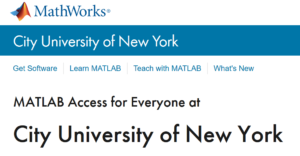Differential equations and computers have a long history. In fact, some of the earliest applications of electronic computers was in the field of differential equations.
Here is a list of of some software, programs, and online compilers which can be applied to differential equations.
Maple
Maple is a powerful and widely used mathematics program, especially in academia. It has a very powerful, easy to use Computer Algebra System for symbolic calculations. Unfortunately, Maple is not free. However, CUNY students can download Maple for free from:
https://offers.cuny.edu/
Maple Download Instructions (for CUNY students). Go to https://offers.cuny.edu/ Log on. Then scroll down a little. Click on “Software” (see below left). Then click on “Maple for Windows (or Mac)” (see below right).

In the Videos Section of this website you can find examples of how to use Maple to solve differential equations.
Matlab and Octave
Perhaps the most widely used mathematics software in engineering is Matlab. Unfortunately, Matlab is not free. However, CUNY students can run Matlab in the cloud for free, or download a copy of the software from:
https://www.mathworks.com/academia/tah-portal/city-university-of-new-york-1111017.html
Octave (free Matlab clone)
There also exists a free “version” of Matlab called, Octave.
Octave and Matlab use the same syntax and commands. You can download Octave for free from: https://www.gnu.org/software/octave/
If you don’t want to download Octave, you can run Octave (Matlab) scripts for free in the following online Octave\Matlab compilers:
Online Octave\Matlab Compilers
https://rextester.com/l/octave_online_compiler
https://www.tutorialspoint.com/execute_matlab_online.php
https://octave-online.net/
Python
Python is probably the most widely used font-end language for Artificial Intelligence (Machine Learning) applications. It also is one of the most popular languages for scientific computing.
If you don’t want to download Python, one of the best online Python 3 compilers is https://trinket.io/features/python3 What sets this online compiler apart is that it works well with plotting.
Perhaps the best and easiest way to get started with Python, especially for the sciences and engineering, is to download, to your computer, Anaconda which is a FREE Integrated Development Environment (IDE) for Python. You write your Python programs and run them in Spyder which is part of Anaconda. https://www.anaconda.com/
Machine Learning (AI) Applications with Python
TensorFlow Keras Spyder Installations Help
If you are interested in using Python for Machine Learning here are the instructions on how to install TensorFlow and Keras so that they work with the Anaconda Spyder Python IDE:
Instructions for installation. I assume you have already installed Anaconda Python.
- Open the Anaconda prompt as an administrator.
To do this in Windows, click on the search magnifying glass at the left side, bottom of the screen, and search for Anaconda Prompt. In Windows 10, to run a program as administrator, you find the program in the start menu and then click on the “>” and choose “run as an administrator”. - At the Anaconda prompt (which is like a DOS Command Window) run the command
conda install tensorflowconda install keras
- To test the installation. Load Spyder. Put the following at the start of a new Python script in Spyder:
import tensorflow as tf
from tensorflow import kerasprint(tf.__version__)
- Run the script in Spyder. If everything is OK, you should get a message like:
1.13.1
You are done! Here are links to TensorFlow and Keras:
R
Perhaps the most widely used language for statistics and data analysis by professional statisticians and scientists is R. R is open source and can be downloaded for free from https://www.r-project.org/
If you don’t want to download R, you can run R scripts for free in the following online R compilers:
Online R Compilers
https://rextester.com/l/r_online_compiler
https://rdrr.io/snippets/
https://www.tutorialspoint.com/execute_r_online.php



